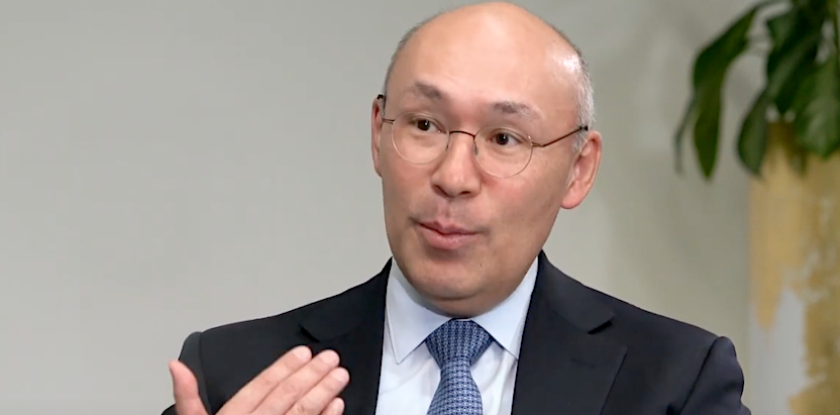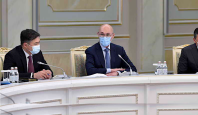In our article ‘Should We Expect Reforms from Kelimbetov?”, we’ve prophesied a bright future for the Chairman of the Agency for Strategic Planning and Reforms (ASPAR) regarding his service of Akorda and a complete failure regarding his service of the people. The only thing that we cannot predict at this point is when those in Akorda would comprehend it. But we have no doubt that, sooner or later, it’s bound to happen.
To confirm it, let us recall the previous strategically-important project initiated by the First President of the Republic of Kazakhstan and the “Leader of the Nation” Nursultan Nazarbayev and “successfully” implemented by Kelimbetov. We are talking about the International Financial Centre ‘Astana’ (IFCA). The very same agency that was suppose to dissociate Kazakhstan from the Central Asian autocracies, elevate it to an unprecedented level and bring international glory to it (while, of course, adding the Elbasy to the bargain).
We have touched upon this subject numerous times. The latest publication titled ‘A Commentary on Kelimbetov’s Appointment’ was released on September 23, 2020, soon after the creation (or recreation) of the ASAP. To those interested in the matter, we also recommend reading our article ‘Why Is MFC ‘Astana’ Doomed to Fail?’ in which we present a detailed history of the project and give our assessment of it.
Here is the forecast we make in the article:
“Thus, starting from July 6, 2018, IFCA has been operating in Kazakhstan. President Nursultan Nazarbayev, Prime Minister Bakytzhan Sagintayev, and IFCA Managing Director Kayrat Kemimbetov have big hopes for this organization. However, we believe these hopes to be completely unfounded. And not only because Akorda’s previous attempt to create an international financial center in Almaty had failed.
Our concerns are primarily caused by the fact that Nursultan Nazarbayev, at the behest of his closest allies particularly Kayrat Kelimbetov, sanctioned the use (implementation) of the model that had proven to be successful abroad. This model, however, cannot be adopted in Kazakhstan due to the absence of certain criteria both objective and subjective.
To solve this systemic problem, the IFCA creators were forced to model it as an offshore organization. The fact that not an even somewhat «alive» stock market exists in Kazakhstan had also played into making this decision since, historically, the presence of a working stock-market always precedes the formation of international financial centers being their necessary and organic part.
Thus, de-facto, IFCA is an economic zone (organization) that, on one hand, is «hanging up in the air» so to speak since it has not been logically and historically generated by the local market and, therefore, cannot rely on it. On the other hand, this organization grants enormous benefits both tax and legal to its members. Therefore, the probability that the form (offshore, in this case) will prevail over the substance is close to 100% especially given the high corruption level among the Kazakhstan authorities”.
“We believe IFCA is a truly important project of the national significance. However, it is doomed to fail due to the following reasons.
- It is foreign not only to the Kazakhstan economy and society but also to the ruling elite that is avoiding the stock market like the plague.
- It has been initiated and carried out by the state, it was not born by the market itself and, therefore, for this reason alone, it will not be economically viable.
- The attempt to create an offshore zone in the corrupt country is likely to cause corruption at IFCA as well.
- The investments in IFCA will not equal the investments in the country’s economy. Moreover, they are unlikely to reach beyond the zone and, therefore, will not exert a positive influence on the level, quality, and effectiveness of the national economy let alone the level of life of most Kazakhstanis”.
Now then, when writing ‘Should We Expect Reforms from Kelimbetov?’, we got interested in the IFCA reports on the business performance. For instance, our attention was caught by Astana International Exchange’s (the stock-exchange operating on the territory of the IFCA) official statements. This is how the information is presented on its webpage (quoting).
“The AIX presents a wide range of opportunities for the global investment community. The AIX’s mission lies in the development of a strong capital market in Kazakhstan and in the Central Asian region by means of providing clear and easy terms to help attracting local and foreign investors as well as in the creation of a platform for financing the growth of private businesses and the economy in general.
The AIX is operating as part of the regulatory and legal environment familiar to international investors - within the jurisdiction of the English law. The stock exchange provides a reliable and safe trading infrastructure with access to investments thanks to a developed ecosystem of 23 local and international traders.
AIX’ shareholders include the IFCA, Goldman Sachs, the Shanghai Stock Exchange, the Silk Road Fund and the NASDAQ”.
This is all very well except that the AIFC’ performance results don’t seem to be at all impressive.
For instance, the press-release of December 22, 2020, titled “The AIX Presents the 2020 Performance Results”, proudly begins with “as of November 2020, the AIX’ monthly trade volume surpasses the last year’s figure by six times”.
But as soon as the reader gets excited about the AIFC’ and Kayrat Kelimbetov’s success, they are quickly brought down back to Earth after learning that “AIX is happy to inform that, in November 2020, the monthly trade value had grown and constitutes US$3.7 mln against last year’s US$659 thousands”.
In our opinion, such trade volumes are OK for a stock exchange operating in a rural area. However, in no way is it acceptable for a strategically-important project implemented by order of the “Leader of the Nation” himself. Moreover, we strongly suspect that the monthly expenses on the AIFC maintenance are quite comparable with its monthly trade value.
Next, the aforementioned press-release lists the “AIX’ achievements as of December 2020”. For the sake of the objectivity, let us quote them ad verbum.
“Almost 80 items including shares and GDRs, securities, ETFs and notes had been listed.
The shares/GDRs of large emitters such as Kaspi.kz (IPO), Kazatomprom (SPO), Ferro-Alloy and Kcell (cross-listing) had been successfully listed.
Starting from 2018, the AIX emitters had attracted more than US$321 mln of owner’s capital (US$104 mln in 2020).
US$8.6 bln of debt capital had been attracted through the AIX (US$3.7 bln in 2020). 26 traders operating including Kazakh brokers as well as brokers from China, Russia and Europe. 98 thousand accounts opened in AIX CSD”.
Nonetheless, we must admit that the AIFC’ turnover is growing. The next press-release on the December 2020 performance results shows that “the total trade value constitutes US$9 265 300,04 (3 895 811 311,64 tenge)”. And, in January 2021, it grew up to US$11 082 201, 24 which equals 4 654 452 560 tenge and surpasses last year’s figure by 20%”.
We do not know whether we should laugh of cry when reading this kind of reports considering that, apart from the AIX, a number of other structures including a special court formed “out of most respected British judges” (the court that, undoubtedly, costs a pretty penny to Kazakhstan) is operating as part of the AIFC project.
And Kelimbetov who has retained his post of the AIFC Governor and has been appointed the Chairman of the Agency for Strategic Planning and Reforms still serves as the leader of the entire project.
It looks like this man is a truly unique specialist. A specialist in what people usually call “showing off”.
So, now we have only two questions to ask.
First – how many salaries does he receive (one or two) and what is their amount?
Second – how much does the show skilfully performed by Kelimbetov and patronised by Nazarbayev and Tokayev is costing to Kazakhstan?





